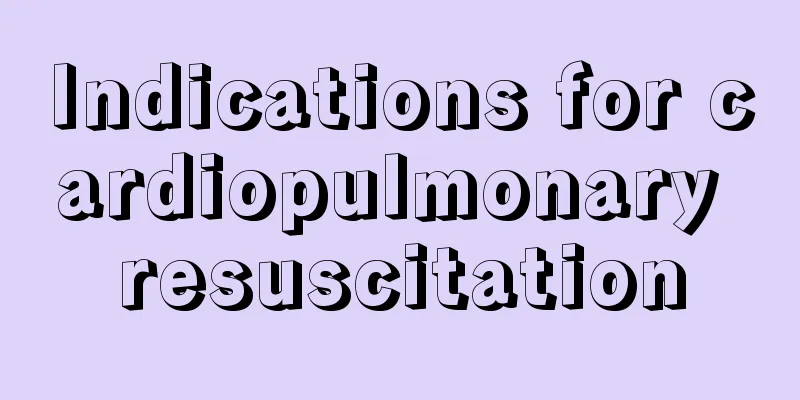Indications for cardiopulmonary resuscitation

|
I believe that many people do not know the treatment targets and treatment objectives of cardiopulmonary resuscitation. In order to increase everyone's understanding of this treatment method, it is recommended that you read the following content. Cardiopulmonary resuscitation is mainly used to treat the symptoms of fainting. It delivers oxygen to the lungs artificially and combines it with external cardiac massage to promote the exchange of oxygen from the lungs. It is a good treatment for promoting heartbeat. Principles of CPR The air contains 80% nitrogen, 20% oxygen and trace amounts of other gases. Chemical analysis of the air exhaled by the human body shows that nitrogen still accounts for about 80%, while oxygen has dropped to 16% and carbon dioxide accounts for 4%. This analysis allows us to understand that the amount of oxygen in the air exhaled through normal breathing is still sufficient to meet our normal needs. Artificial respiration is used to blow air into the lung cavity, and then combined with external cardiac massage to encourage blood to exchange oxygen from the lungs and then circulate to the brain and the whole body to maintain the survival of brain cells and organ tissues. Importance of CPR The human body relies on the beating of the heart, the rhythmic movement of blood vessels and the breathing of the lungs to transport oxygen and nutrients to all parts of the body for normal body activities; and expel carbon dioxide and waste from the body through blood flow and breathing. Under normal circumstances, if the heart stops beating, that is, the brain tissue is deprived of oxygen within 4 minutes, the original function can be restored. If the heart stops beating for more than 4 minutes, it is easy to cause permanent damage to the brain tissue and even lead to death. Therefore, rescue of such wounded persons must be timely and rapid, so as to try to save their lives. Indications and contraindications for cardiopulmonary resuscitation 1. Indications Respiratory and circulatory arrest due to various reasons (including cardiac arrest, ventricular fibrillation and extremely weak heartbeat) 2. Contraindications Open chest wall injury; rib fracture; chest deformity or pericardial tamponade. Medical education: Patients with irreversible failure of important organs such as heart, lung, and brain do not need resuscitation, such as advanced cancer. Steps of CPR 1. Judgment awareness Pat the patient's shoulders with both hands and call the patient to observe whether there is any response. 2. Call for help Immediately call other medical personnel for rescue and bring a defibrillator. 3. Determine heartbeat and breathing Lift the quilt, unbutton the outer clothes, touch the carotid artery, and observe the rise and fall of the chest to determine the heartbeat and breathing conditions. If the heart stops beating or breathing stops, perform cardiopulmonary resuscitation immediately and record the start time of rescue. 4. Chest compressions ① Preparation: Move the bedside table away, quickly let the patient lie flat without a pillow, place a pressure board under the chest, and use a footstool as a footrest. ②30 chest compressions (17 seconds to complete): A. Location: The midpoint of the line connecting the two nipples or two horizontal fingers above the xiphoid process B. Technique: Use the method of overlapping your hands, straighten your wrists and elbows, and use your body gravity to press vertically downward. C. Depth: sternum depression ≥ 5cm D. Frequency: ≥100 times/min 5. Open the airway ①Clear the respiratory tract: Turn the patient's head to one side and use the right index finger to clean foreign objects in the mouth ② Open the airway: The methods to open the airway include lying on the back with the chin lifted and jaw lifted. The commonly used supine chin-lift method is that the rescuer places the hypothenar of his left hand on the patient's forehead and presses the palm backwards to make the head tilt back. The middle finger and index finger of his right hand are separated in a scissors shape and placed under the patient's chin and lifted upwards to straighten the airway. It is forbidden for patients with neck injuries to avoid damaging the spinal cord. 6. Artificial respiration Use a simple respirator to ventilate twice, use the "EC technique", perform artificial respiration once every 6-8 seconds, 8-10 times/minute, each breath is about 1 second, ventilation is about 0.5 liters, and the chest can be seen rising and falling. 7. Continue CPR Continue cardiopulmonary resuscitation with a ratio of chest compression to artificial respiration of 30:2, and repeat this method repeatedly until recovery is achieved. 8. Observe the effective signs of cardiopulmonary resuscitation ①Observe the heartbeat and breathing: touch the carotid artery (10 seconds) and observe the breathing. ② Observational awareness: observe pupil changes, orbital pressure reaction, and light reflex. ③Observe circulation: observe changes in cyanosis of the face, lips, and nail beds, improvements in peripheral circulation, and measure blood pressure. ④ Determine whether resuscitation is successful: continue to provide advanced life support. |
<<: What to do if herpes appears around the mouth
Recommend
Is it life-threatening to faint from an injection?
Getting acupuncture is a very normal condition fo...
Can I eat salty food during confinement?
With the development of society, people's tas...
What's going on with mental confusion
If your pace of life is too fast, or you are unde...
What causes back pain and leg soreness? How to treat it?
Back pain and leg soreness are annoying symptoms ...
It is healthiest to "suffer" appropriately in cold winter
In the cold winter, people are always constantly ...
What are the symptoms of advanced liver cancer
There are many symptoms of advanced liver cancer,...
What are some ways to prevent liver cancer?
Diseases are always ruthless, and malignant tumor...
Female massage improves sexual function
Women in modern society are under great work pres...
What are the symptoms of nasopharyngeal cancer? Will there be nosebleeds?
What are the symptoms of nasopharyngeal cancer? W...
What is the reason for numbness in the big toe
Friends who have numbness in the big toe should p...
Pay attention to the symptoms and characteristics of kidney cancer in life
Some people are more likely to develop kidney can...
How to deal with a husband with a bad temper
When a couple lives together, they need to unders...
Diet care for fever caused by liver cancer
We must not ignore liver cancer. First of all, we...
There are a lot of pustules in my hair
When it comes to pustules, many people will feel ...
What are the advantages and disadvantages of sleeping naked
Sleeping naked is a word we often hear in our dai...









